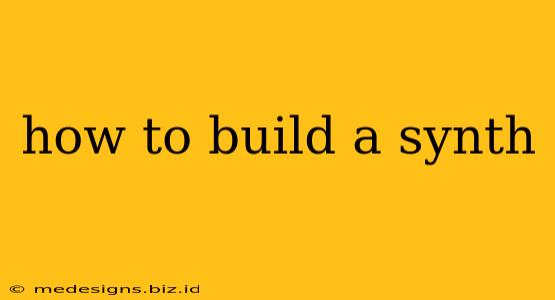Building your own synthesizer might seem daunting, but it's a rewarding journey into the heart of electronic music. This guide breaks down the process into manageable steps, whether you're a seasoned electronics engineer or a curious beginner. We'll cover the fundamental components and different approaches to synth building, from simple oscillators to more complex modular systems.
Understanding the Building Blocks of a Synthesizer
Before diving into the construction, it's crucial to understand the basic components that make a synthesizer "sing":
1. Oscillator: The Sound Source
The oscillator is the heart of any synth. It generates the raw sound waves – the fundamental tones that form the basis of your sound. Common types include:
- Sawtooth: Bright, rich, and often used for leads.
- Square: Sharp, powerful, and ideal for basses or percussive sounds.
- Triangle: Smooth, mellow, and often used for pads or mellow soundscapes.
- Sine: Pure, smooth tone; often used as a foundation or mixed with other waveforms.
Many synthesizers use multiple oscillators, allowing for complex sounds through layering and detuning.
2. Filter: Shaping the Sound
The filter sculpts the sound generated by the oscillator, removing or emphasizing certain frequencies. Common filter types include:
- Low-pass: Allows low frequencies to pass while attenuating higher frequencies.
- High-pass: Allows high frequencies to pass while attenuating lower frequencies.
- Band-pass: Allows a specific range of frequencies to pass.
- Notch (Band-reject): Removes a specific range of frequencies.
Filters are essential for shaping the timbre and character of your sounds.
3. Envelope Generator (EG): Controlling Dynamics
The envelope generator controls the amplitude (volume) of the sound over time. It usually consists of four stages:
- Attack: How quickly the sound reaches its peak volume.
- Decay: How quickly the sound decays from its peak to the sustain level.
- Sustain: The volume level maintained while a key is held down.
- Release: How quickly the sound fades out after the key is released.
The envelope generator adds expressiveness and dynamic variation to your sounds.
4. LFO (Low-Frequency Oscillator): Modulation Magic
The LFO is a slow oscillator used to modulate various parameters of the synthesizer, adding vibrato, tremolo, or other rhythmic effects. It's particularly useful for creating movement and depth in your sounds.
5. VCA (Voltage-Controlled Amplifier): Volume Control
The VCA controls the overall volume of the sound, often modulated by the envelope generator or other control sources.
Choosing Your Synth Building Approach
There are several ways to build a synthesizer, each with its own level of complexity and cost:
1. Kit-Based Synthesizers: A Great Starting Point
Many companies offer synthesizer kits, providing all the necessary components and instructions. This is a fantastic way to learn about synth architecture without the need for extensive electronics knowledge.
2. Modular Synthesizers: The Ultimate Customization
Building a modular synth involves assembling individual modules, such as oscillators, filters, and envelopes, to create a custom system. This offers immense flexibility but requires more technical expertise.
3. Designing from Scratch: Advanced Synth Building
Designing and building a synthesizer from scratch requires a deep understanding of electronics and circuit design. This is a challenging but extremely rewarding endeavor.
Tools and Resources for Synth Building
Building a synth requires various tools, including:
- Soldering iron and solder: Essential for connecting components.
- Multimeter: For testing circuits and components.
- Breadboard: For prototyping and testing circuits.
- Schematic diagrams and PCB layouts: To guide the construction process.
Software Resources: Many online resources, including tutorials and schematics, are available to assist you in your synth-building journey. Explore online forums and communities dedicated to synthesizer construction.
Safety First!
Always prioritize safety when working with electronics. Take precautions to avoid electrical shocks and burns.
Building your own synthesizer is an exciting and challenging project. Start with a simple kit or explore online resources to find a path that suits your skills and ambitions. The sounds you create will be uniquely yours, a testament to your creativity and technical prowess.
